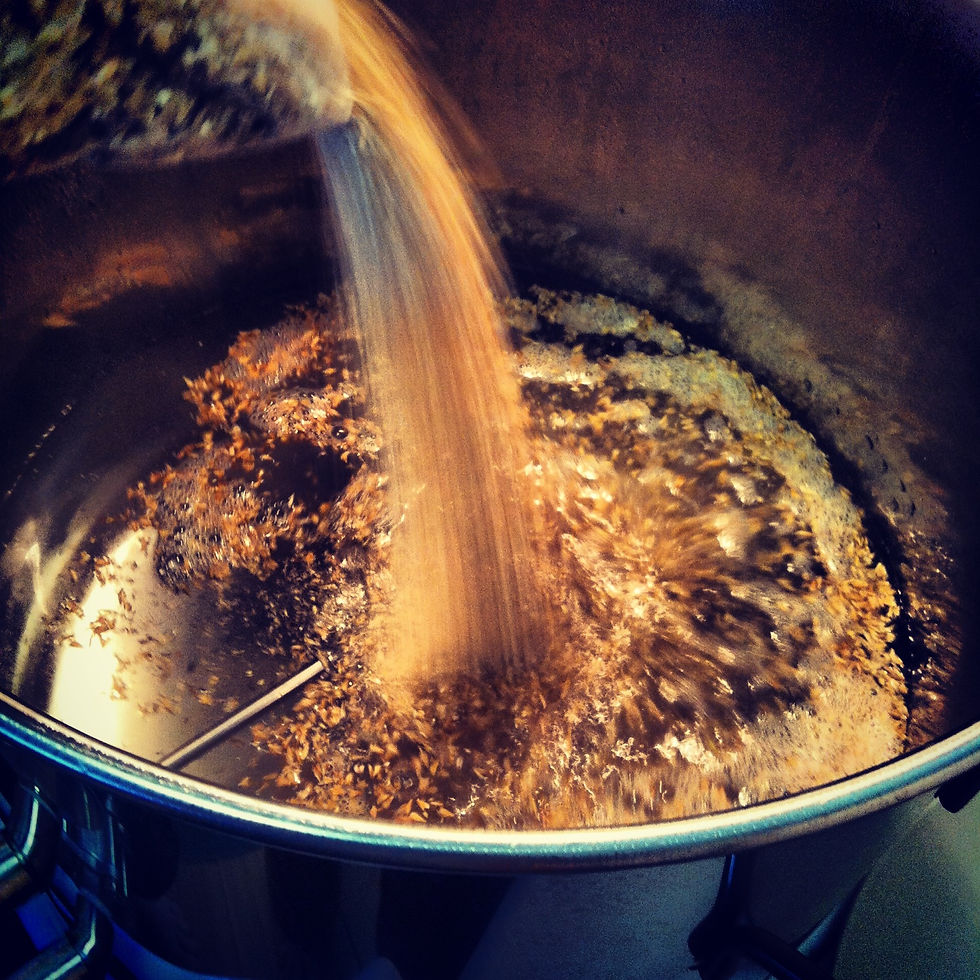



ground grains, carapils, Black Patent, 2-Row.









Brewing Beer
Water + Grain + Heat + Hops + Yeast + Time = Beer. DONE.
It’s that easy. But it’s really not.
GRAINS
Let’s start with GRAINS. You usually start with barley and/or wheat. This is a high quality version of what you would put in your soups or breads. If you want it for beer, you need to WET and KILN it. This let’s the grain GERMINATE which makes it possible for it to release more sugar and turns it into MALT.
From there, you can ROAST it. This darkens the malt to get your desired SRM and subtle flavor differences. Roasting malts can add a honey, toffee, caramel, coffee, or chocolate flavor to your beer.
Next you MILL or GRIND desired grains to create your grain bill.
MASH-LAUTERING
LAUTERING is the word for extracting sugars from your grains where MASH is the name for grain that’s being soaked with hot water to get that sugar. Different temperatures will extract different types of proteins and sugars. When lautering, lower temperatures create a thicker beer, where higher temperatures create a more alcoholic beer.
Lautering creates WORT, which is sugar water that comes from your grains. You can look at as ‘beer juice’, beer before it becomes beer.
BOILING.
After all the sugars are out, you need to condense the wort and add the desired hoppiness and flavors. This requires BOILING. Lots and lots of boiling. When boiling, you decide when you want to add hops or other flavors you wish to add such as spices, chocolate, coffee, sugars, or lactose.
Based on their alpha acids, depending on how long you boil hops determines how much bitterness or aroma you get out of them. Longer hop boiling = more bitterness, Less hop boiling = more aroma.
Think of hops as the salty to the sweet. When cooking, a good way to counterbalance sweetness is to add a saltiness. Hops do the same, but with bitterness.
There are many different kinds of hops that have different flavors profiles.
COOLING AND FERMENTING.
Remember the yeast I was talking about before? They like certain temperatures. It’s important to cool off your wort as quickly as you can to their ideal temperature. You do this using a wort chiller or heat exchanger. Your hot wort goes through a radiator an gets chilled with the power of air, cold water, and surface area.
Once cooled, you put the wort into a fermenter as well as the yeast you want to use. This is where your wort becomes BEER. Depending on your beer, sugar levels, and temperature, this can take up to 2 weeks.
DRY-HOPPING
Remember when I said that the later you add hops to your wort when boiling, the more aroma you get? This is the mack-daddy method of getting aroma in a beer. Forget cooking the hops in the wort. With dry hopping, you’re throwing hops in the beer AFTER cooking AND after fermentation. You’re basically letting all those delicious smells take a bath in malty-hoppy goodness that will become your beer.
KEGGING
Kegging is the simple part. You add yeast and pump the beer into kegs. Adding yeast creates carbonation. As I said before about yeast, their by-products are alcohol and CO2. If you don’t let CO2 escape, it creates carbonation. After a couple days of carbonating, the kegs are ready to be shipped off to the consumer.
Finally, the most overlooked, worst, and time consuming step:
CLEANING AND SANITIZING
If I was to list the most important things that make a good beer taste the way it does, cleaning and sanitizing would be third after water and yeast. A dirty fermenter can ruin an entire batch of beer.
